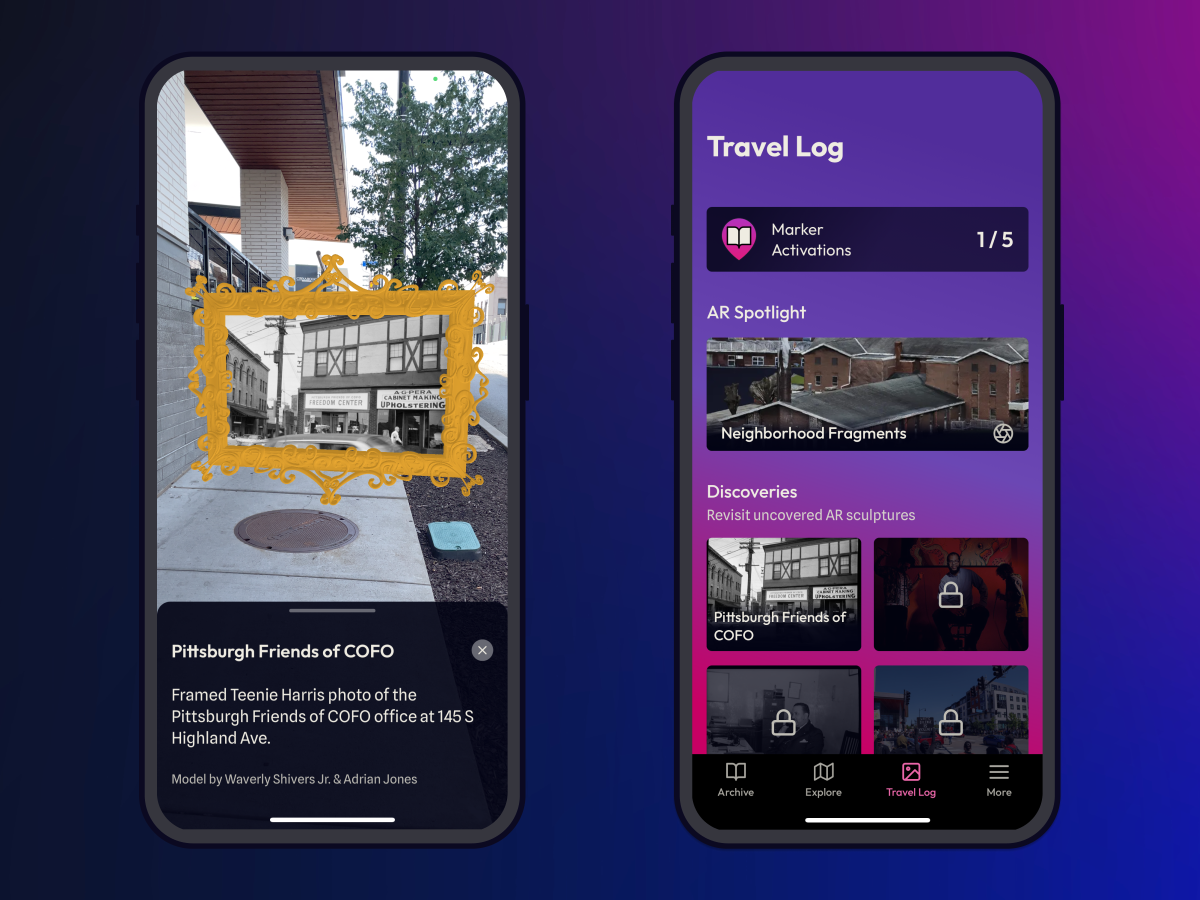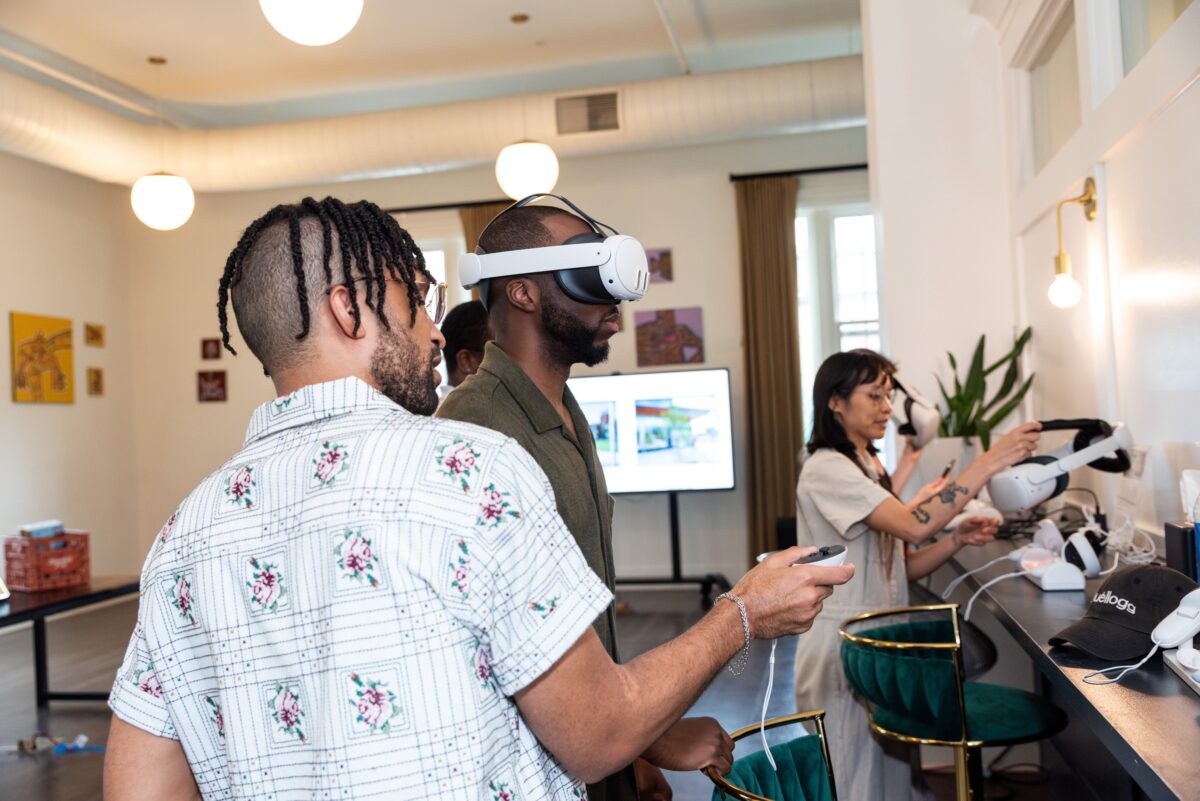Creative technologist Adrian Jones embarked on a new project with a meaningful vision: to mirror Pittsburgh’s past with its present, unveiling stories and wisdom to inform a better future.
His plan was to do it all right from our smartphones.
Jones brought this vision to life by founding Looking Glass, an interactive app-based archive that uncovers hidden stories of Black life in Pittsburgh.

Launched in June, the app blends augmented reality (AR) with historical archives to connect the past, present and imagined futures. Users can travel through Pittsburgh and, along the way, uncover memories that shaped the city’s neighborhoods. For now, the app primarily spotlights East Liberty’s rich history.
“It was important to me that it started with East Liberty because of what that represents in terms of a neighborhood being radically transformed and so many people being displaced,” Jones said.
According to East Liberty Development, Inc., the neighborhood was home to a vibrant commercial district and close-knit residential community in the 1940s and 1950s. It declined rapidly in the 1960s after an urban renewal program set out to remake East Liberty into a district that could compete with new suburban markets.
While well-intentioned, this initiative caused a deconstruction of East Liberty that made it largely unrecognizable and inaccessible, forcing disruption and dislocation of residents. The new AR app shows how some notable places evolved alongside the neighborhood.
Looking Glass’s primary feature is the explore view, where users navigate a map dotted with markers of significant people, events and institutions. Explorers can activate site-specific AR sculptures and view artifacts like photos and videos.
“I was struck by this question of, what if it were possible to unearth history that’s buried?” Jones said. “AR is one of those things that offers that type of creative possibility.”
Documenting gentrification through art and technology
Jones’s journey toward creating Looking Glass began when he relocated to Pittsburgh from Harrisburg in 2017.
After exploring Pittsburgh’s archives, hearing community stories and reflecting on his own experiences, he became interested in the cycle of disinvestment and displacement – or the erasure caused by gentrification.
His interest catalyzed into an idea during his participation in the first cohort of Collective Action School, an online experimental school for tech workers blending activism, design and software engineering disciplines. The year’s theme, Creative Protest, inspired Jones to create what ultimately became Looking Glass.

“I understood creative protest as a call to take inventory of my skills and the issues in my immediate environment so that I could find a place to strategically intervene and serve my community,” Jones said. “I had this vision of a lens that could reveal the history and stories buried in plain sight, particularly in gentrified neighborhoods.”
The project was overseen by advisors Xiaowei Wang, Ph.D., and Dorothy R. Santos, Ph.D., both accomplished writers, artists and scholars who serve as stewards of Collective Action School.
“I think this project is a celebration of Black joy, Black life, Black history and also Black futures of Pittsburgh,” said Wang. “There’s so much rich history of resistance and community in places like Pittsburgh.”
Wang and Santos, along with two others, founded Collective Action School–originally called Logic School–in response to the growing demand for change in the tech industry. They envisioned a program that offered a critical, interdisciplinary approach to technology. The school was born to equip tech workers with tools and knowledge to transform the industry from the bottom up, emphasizing community building and issues of justice in tech.
An independent technologist surrounded by diverse support
Notably, Jones built the technical infrastructure for Looking Glass by himself, eliminating common constraints faced in app development like costly licensing fees, data harvesting and user surveillance.
Self-authoring the app ensured greater protections and empowered Jones to shape the user experience completely.
“I think it’s important that there are more instances of technology that are solely created and shaped by the hands of folks of color,” Jones said. “It’s important and a distinguishing element that [Looking Glass] is self-authored and can be owned by the community of contributors, entirely made by Black and Brown hands.”
Jones also involved a diverse group of BIPOC contributors in the creation of Looking Glass and its features, spanning mediums like soundscape, videography and branding design.
Pittsburgh-born singer-songwriter, musician, producer and audio engineer Danielle Walker, known as INEZ, produced original music for the app. She said her songs reflect on the upheaval of East Liberty residents and the reclamation of its identity, pushing back against gentrification.
Walker said that having this record on a mobile device and viewing landmarks through an AR lens will ensure “erasure happens less — that the families who were in East Liberty and know its heart will get to keep a piece of it, even as it changes.”
A spotlight on Black history and the power of collective action
The app launched its beta on June 29 at Emerald City in downtown Pittsburgh, bringing together collaborators and supporters to celebrate the app and explore other interactive story stations.
One room featured three virtual reality (VR) stations, where guests immersed themselves in experiences of Black art, history and remembrance. Another room showcased a short film directed by Jones called “A Walk to Enterprise & Frankstown,” offering viewers a POV walk to the site where Local 471, Pittsburgh’s former Black musicians union, once stood.
The app is currently available for download on iOS and will soon launch for Android. Features are added on a rolling basis, with the Android beta expected in August.
Looking ahead, Jones plans to incorporate new features into Looking Glass, including an audio library where people can listen to oral histories alongside original music by local musicians.
“I want the archive to be able to house stories from all over the city. East Liberty is just the start,” Jones said. “There are stories that are right under our feet, everywhere.”
Moreover, Jones hopes that Looking Glass will serve as a blueprint for similar projects in other cities.
“Collectively, what I hope will be the result of creating this tool for people to more easily access Black stories and these visions of Black futures,” Jones said. “This is about opening up pathways to healing, and for collective action.”
Join our growing Slack community
Join 5,000 tech professionals and entrepreneurs in our community Slack today!
Donate to the Journalism Fund
Your support powers our independent journalism. Unlike most business-media outlets, we don’t have a paywall. Instead, we count on your personal and organizational contributions.

National AI safety group and CHIPS for America at risk with latest Trump administration firings

How AI is infiltrating labor union contracts, in Pittsburgh and beyond

How women can succeed in male-dominated trades like robotics, according to one worker who’s done it



